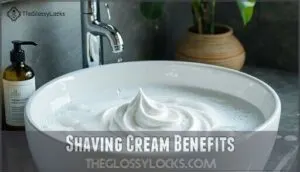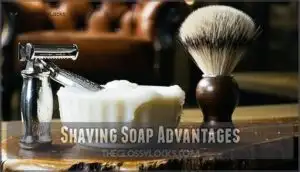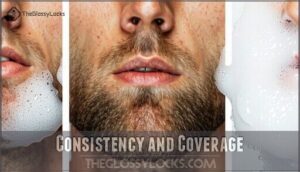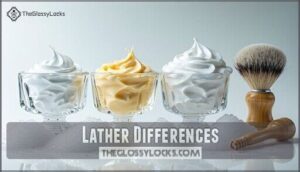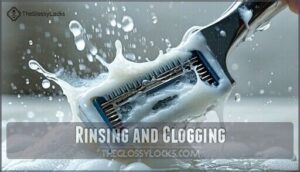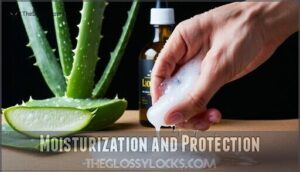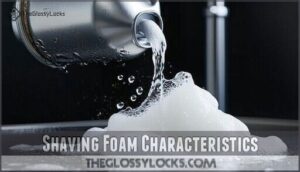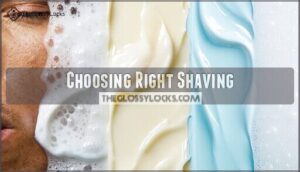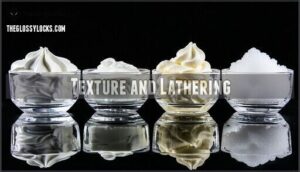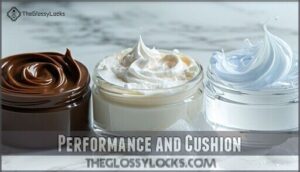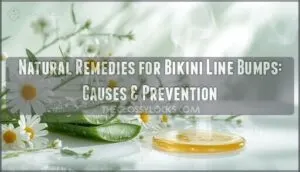This site is supported by our readers. We may earn a commission, at no cost to you, if you purchase through links.
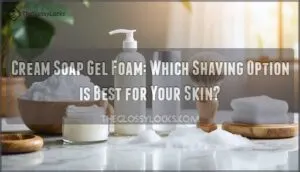
Creams provide rich moisture for sensitive skin, while traditional soaps offer satisfying lather and work well with vintage razors.
Gels give you transparent application for precision around facial contours, and foams provide quick, convenient coverage.
Your skin type matters: dry skin benefits from cream’s hydration, oily skin responds well to soap’s cleansing properties, and normal skin works with any option.
Like choosing the right tool for a job, selecting the perfect cream soap gel foam product can transform your daily shaving routine from a chore into a comfortable ritual, and make it a more enjoyable experience with the right shaving products.
Table Of Contents
- Key Takeaways
- Shaving Cream Benefits
- Shaving Soap Advantages
- Shaving Gel Options
- Shaving Foam Characteristics
- Choosing Right Shaving
- Cream Vs Soap Comparison
- Gel Vs Foam Differences
- Frequently Asked Questions (FAQs)
- Which is best, shaving cream or gel or foam?
- Is shaving cream or gel better for safety razors?
- What is the difference between shaving soap cream and gel?
- Is it better to shave with cream or soap?
- Is shaving cream or gel better for legs?
- Is shaving foam the same as shaving cream & soap?
- Is shaving foam better than shaving gel?
- Why should you use shaving gel instead of shaving cream?
- What is a shaving foam can?
- How do you use shaving foam?
- Conclusion
Key Takeaways
- Your skin type should guide your choice: creams provide rich moisture for sensitive or dry skin, soaps work best for oily skin with their cleansing properties, gels offer precision application with transparent application, and foams deliver quick convenience.
- Shaving creams excel at extreme moisturization with natural ingredients like aloe vera and shea butter, making them ideal for sensitive skin while providing lasting hydration and softness.
- Traditional shaving soaps create excellent lubrication that pairs perfectly with vintage razors, offering skin brightening benefits and oil control for oily or normal skin types.
- You’ll find gels provide superior visibility for precision shaving around facial contours, while foams offer quick application with no lathering needed, though they provide less protection than other options.
Shaving Cream Benefits
Shaving cream gives your skin the hydration it craves while making the razor glide effortlessly.
Its rich texture, often packed with soothing natural ingredients, is perfect for keeping sensitive or dry skin calm and smooth, providing the hydration it needs.
Extreme Moisturization
Shaving creams excel at extreme moisturization, keeping your skin hydrated longer than other options.
Packed with ingredient benefits like aloe vera and shea butter, they soothe dry skin and sensitive skin while reinforcing your skin barrier.
Think of it as a moisturizing soap that doubles as a sensitive solution, ensuring post-shave care feels luxurious, not irritating.
Perfect for lasting hydration duration!
Suitable for All Skin Types
One product’s universal appeal means you don’t need to worry about purchasing separate shaving solutions for different family members.
Shaving cream’s versatility makes it a staple in bathrooms everywhere, working effectively across all skin types.
- Ingredient sensitivity is rarely an issue with quality cream soap formulations
- Hydration levels remain balanced regardless of whether your skin is oily or dry
- Irritation prevention is built into its design, unlike foam products that may aggravate sensitive skin, providing irritation prevention and maintaining hydration levels.
Natural Ingredients for Soothing
Many quality shaving creams contain natural ingredients like aloe vera and shea butter that calm irritated skin.
You’ll find hyaluronic acid and natural oils providing exceptional soothing benefits during your shave.
Unlike some foam products, cream soap formulations with glycerin benefits help prevent razor burn and bumps.
These gentle components work together to protect sensitive skin while still delivering a close shave that won’t leave you feeling raw afterward, thanks to their soothing benefits.
Soft and Hydrated Skin
After every shave, you’ll notice your skin feels remarkably soft and hydrated when using quality shaving cream.
The moisture-rich ingredients penetrate beyond the surface, reinforcing your skin barrier with each application.
Unlike foam products that can strip natural oils, shaving cream’s formulation locks in hydration.
You’re not just removing hair; you’re treating your skin to a mini-moisturising session.
Consistent use, regardless of shaving frequency, guarantees lasting softness.
Ideal for Sensitive/Dry Skin
While hydrated skin creates the perfect canvas for shaving, those with sensitive or dry skin need extra care.
You’ll find shaving cream particularly beneficial if you’re prone to razor burn or ingredient sensitivity.
I’ll craft a short, engaging blockquote in the same tone as the article:
Shaving cream isn’t just a luxury—it’s your skin’s best defense against the daily battle with razor burn and sensitivity.
Its rich formulation, often containing aloe vera, creates a protective barrier that minimizes shaving irritation.
Unlike harsher alternatives, quality creams hydrate during and after your shave, making post-shave care easier, like a cozy blanket for your vulnerable skin.
Shaving Soap Advantages
You’ll find that traditional shaving soap provides excellent lubrication and leaves your skin feeling refreshed without drying it out.
It’s particularly well-suited for those with oily or normal skin types, creating a thick, creamy lather that pairs perfectly with vintage razors for that classic shaving experience.
Uplifting and Refreshing
While shaving cream offers intense moisture, traditional shaving soap brings an entirely different experience to your morning rituals.
The rich, aromatic benefits of quality soap gel can transform your shave into a spa-like escape.
Many contain cooling ingredients like menthol that wake up your senses and invigorate your skin. The scent profiles available range from classic barbershop to exotic woods, creating a post-shave feel that’s refreshingly clean and brightened.
Lubrication for Smooth Shave
While feeling refreshed is nice, proper lubrication is what truly matters for your shave.
Good shaving soap creates slick razor glide that helps your blade move smoothly across your skin, preventing irritation.
The formulation works by softening hair and creating a protective barrier between your skin and the razor.
Unlike shaving cream, foam, or gel, traditional soap’s shaving lubrication comes from natural ingredients that provide exceptional product performance without harsh chemicals.
Skin Brightening and Refreshment
Your skin perks up noticeably after using quality shaving soap.
Unlike shaving foam or gel, soap offers exfoliation benefits that reduce dullness and improve tone. The ingredient efficacy in traditional soaps helps wash away dead skin cells while providing skin hydration.
You’ll notice immediate skin refreshment post-shave – that tightened, brightened feeling isn’t just in your head. For best results, follow with proper post-shave care.
Using a quality pre-shave soap can further soften facial hair for an even smoother shave.
Pairing With Vintage Razors
The time-tested harmony between shaving soap and vintage razors creates an authentic traditional shaving experience.
Your vintage razor deserves a partner that enhances its performance while preserving its classic charm.
- Feel the satisfying weight of history in your hand as soap lather cushions each stroke
- Experience the tactile connection to generations of gentlemen before you
- Enjoy the simple pleasure of creating rich, protective lather with a badger brush
- Rediscover the meditative ritual that modern convenience has nearly forgotten
- Transform your morning routine into a moment of self-care and craftsmanship
The lather consistency of quality shaving soap complements blade aggressiveness, providing ideal razor compatibility while addressing skin sensitivity concerns.
Many seek products for vintage razors to complete the shaving experience.
Suitable for Oily/Normal Skin
If you’re battling excess shine throughout the day, shaving soap is your perfect match.
Its specialized soap ingredients help balance oil production while delivering exceptional lather quality.
You’ll notice improved razor compatibility with less clogging, as the soap efficiently cuts through natural oils.
Your post-shave feel will include natural oil control without the tight, stripped feeling that foam or shaving gel sometimes causes on normal skin, providing a better post-shave feel and ensuring less clogging.
Shaving Gel Options
You’ll find shaving gels provide excellent lubrication while allowing you to see exactly where you’re shaving through their clear application.
They’re less foamy than other options but offer superior protection against nicks and cuts, making them ideal for anyone with sensitive skin.
Consistency and Coverage
While shaving soap offers invigorating benefits, shaving gel provides unique consistency advantages.
You’ll notice gel’s slicker texture creates:
- Superior razor glide across all contours
- Excellent application evenness without patchy spots
- Complete hair coverage, even in tricky areas
The shaving product consistency of gel means it won’t drip like foam or cream might.
Its semi-transparent foam layer also lets you see exactly where you’re shaving, unlike the thick lather of other options.
Finding the right product depends on shaving gel properties.
Lather Differences
Now that you’ve got your gel coverage sorted, let’s talk about how different products create lather.
The way your shaving product lathers makes a huge difference in your shave quality.
| Product Type | Lather Density | Lather Stability | Application Method |
|---|---|---|---|
| Shaving Gel | Lower, slicker | Longer lasting | Direct application |
| Shaving Cream | Rich, creamy | Highly stable | Brush or fingers |
| Shaving Foam | Light, airy | Dissipates quickly | Spray directly |
| Shaving Soap | Dense, luxurious | Very stable | Requires brush |
You’ll notice gels create less actual lather but provide excellent lubrication without the foam. You can find a variety of options for shaving gel products.
Rinsing and Clogging
During your shaving routine, managing gel and foam can be tricky in the context of keeping your razor running smoothly.
Here’s what you need to know about rinsing and clogging issues:
- Using excessive shaving gel increases razor clogging and residue buildup
- Hot water temperature helps dissolve gel residue more effectively
- Increasing rinse frequency prevents blade clogging during your shave
- A bowl of water for blade maintenance works better than running water
- Hair mixed with shaving foam creates more sink-clogging potential
The key to a smooth shave is understanding how to manage these issues, particularly clogging problems that can arise from improper care of your razor.
Moisturization and Protection
Your gel’s hydration levels make a significant difference in skin protection during shaving.
Most quality shaving gels contain moisturizing ingredients that maintain your skin barrier while providing excellent lubrication. The ingredient benefits often include aloe and vitamin E to soothe post-shave care needs.
You’ll notice less razor burn compared to foam products, as gels typically offer superior moisturising properties that remain active throughout your shaving routine, providing excellent lubrication.
Shaving Foam Characteristics
You’ll find shaving foam offers quick application with no lathering needed, making your morning routine faster and simpler.
It works well with multi-blade razors but provides less moisture and protection than traditional options, which might affect your skin’s comfort after shaving.
Foam Cans and Usage
Aerosol cans of shaving foam offer a convenient option for your daily routine, but understanding their usage can improve your shaving experience.
Shaving foam variants typically come in pressurized containers that deliver product with a simple push.
Here’s what you should know about foam cans:
- Foam ingredients often include propellants that may cause skin irritation
- Application techniques require less precision than other products
- Environmental impact concerns exist with aerosol packaging
- Cost effectiveness makes them attractive for everyday use
While quick and straightforward to apply, shaving foam mightn’t provide the same protection as shaving cream or gel for sensitive skin types.
Foam Vs Gel Razors
While canned foam offers quick application, gel-based razors provide superior skin hydration.
You’ll notice gel creates a slicker surface that helps your blade glide smoothly, reducing skin sensitivity issues.
Foam produces a heavier lather but doesn’t match gel’s lubricating qualities.
For shaving precision, especially when sculpting facial hair, gel’s transparency gives you a clear view.
Shaving foam prevents razor burn and irritation, making it a worthwhile choice for many.
Consider your blade clogging concerns and cost comparison when choosing between shaving foam vs gel options.
Foam Convenience Vs Gel Lubrication
The humble shaving foam offers unmatched convenience with its quick application, while gel provides superior lubrication for a smoother glide across your skin.
- Foam application takes seconds—just press and apply—perfect for rushed morning routines
- Shaving gel’s enhanced lubrication quality substantially reduces razor burn and irritation
- Gel typically costs more per use, but many find the improved skin protection worth the extra expense, considering the smooth glide it provides
Foam Lather Vs Gel Transparency
While foam creates a thick, rich lather covering your face entirely, gel offers transparency that helps you see exactly where you’re shaving.
This visibility difference impacts your overall experience substantially.
| Feature | Shaving Foam | Shaving Gel |
|---|---|---|
| Lather Thickness | Very thick, opaque | Thin, transparent |
| Visibility Benefits | Limited visibility | Clear view of skin |
| Application Messiness | Can be messy | Generally neater |
| Razor Clogging | More likely to clog | Less clogging issues |
Choosing Right Shaving
You’ll find the perfect shaving product when you match it to your skin type and personal routine.
Your skin’s needs, shaving frequency, and technique all play important roles in determining whether cream, soap, gel, or foam will give you the best results.
Skin Type Considerations
While spray foam offers quick application, your skin type should guide your shaving product choice.
For oily skin, shaving soaps work best by removing excess without over-drying. If you have sensitive skin or dry skin, creams with ceramides and natural ingredients provide gentle moisturization.
Acne-prone? Look for oil-free gels with salicylic acid. Combination skin benefits from balancing gel formulations.
Remember, product ingredients matter more than fancy packaging when finding your perfect match.
Shaving Frequency
How often you shave impacts which product works best for you.
Your skin’s recovery time between shaves is key to avoiding shaving irritation.
Based on your shaving frequency:
- Daily shavers benefit from gentle shaving creams with extra moisturizers to prevent razor burn
- Every-other-day shavers might prefer shaving gels for better stubble length visibility
- Weekly shavers often need stronger products to tackle longer hair
- Sensitive skin types should consider gentler formulas regardless of shaving frequency
Personal Preferences
Beyond skin type, your shaving product preferences boil down to personal comfort.
Whether you’re drawn to the rich lather of creams, the traditional feel of soaps, the precision of gels, or the convenience of foams depends on your unique needs.
Your razor choice, application style, scent preferences, budget concerns, and sensitivity all influence which product feels right for you.
Trust your experience—you’ll know when you’ve found your perfect match.
Shaving Techniques
Your technique matters as much as your product choice. Consider grain direction first—shave with the grain initially, then across or against for closeness.
Different products require different angles: soap works best with safety razors at 30°, while gels complement cartridge razors.
Pre-shave prep softens hair, and multi-pass shaving with adequate post-shave care prevents irritation. Your shaving routine should adapt to your chosen formula.
Cream Vs Soap Comparison
You’ll notice clear differences between shaving creams and soaps when you compare their texture, performance, and how they work with your skin type.
Creams typically offer more moisture and are easier to lather, while traditional soaps provide excellent slickness and often last longer in your bathroom cabinet.
Texture and Lathering
Now that you understand which product might work best for your skin type, let’s look at how shaving cream and soap differ in texture and lathering properties.
When creating your shaving lather, you’ll notice significant differences between these products. Shaving cream typically produces a rich, immediate lather, while soap requires more work but creates denser foam. Many users prefer soaps with natural oils for their skin hydration benefits.
| Product | Lather Density | Texture Stability | Water Needs |
|---|---|---|---|
| Cream | Medium-High | Very stable | Less water |
| Soap | High | Extremely stable | More water |
| Gel | Low-Medium | Somewhat unstable | Minimal |
| Foam | Low | Unstable | None |
Your brush technique matters too—circular motions work best for both, but soap demands more patience and precision.
Performance and Cushion
Both shaving cream and soap provide different performance benefits that affect your shaving experience.
Cream’s thick cushion protects your skin while soap excels at creating slickness for razor glide.
| Feature | Shaving Cream | Shaving Soap |
|---|---|---|
| Lather Density | Thick, luxurious | Lighter, airier |
| Skin Protection | Superior cushion | Excellent slickness |
| Hair Softening | Highly effective | Good but less moisturizing |
You’ll notice cream’s cushion duration lasts longer, while soap’s slickness helps your razor glide more smoothly over skin.
Convenience and Accessibility
While both offer excellent cushion for your razor, shaving cream takes the lead in convenience.
You’ll find it readily available in most stores and easier to use when traveling.
| Product | Travel Friendliness | Beginner Friendliness | Application Speed |
|---|---|---|---|
| Cream | High (tubes) | Very Easy | Quick |
| Soap | Medium (requires case) | Learning Curve | Takes Time |
Soaps require brushes and bowls, while creams can be applied with fingers in a pinch—perfect for when you’re rushing or packing light, making them a quick and convenient option.
Fragrance Options
While ease of use matters, your nose might’ve the final say! Fragrance options vary widely between shaving creams and soaps, affecting your overall experience.
| Product Type | Scent Intensity | Fragrance Longevity | Allergen Concerns |
|---|---|---|---|
| Shaving Cream | Moderate | Medium | Lower with natural options |
| Shaving Soap | Strong | Long-lasting | Higher with synthetic fragrances |
| Shaving Gel | Mild | Short | Minimal |
| Shaving Foam | Strong | Short | Moderate |
Traditional soap fragrances tend to linger longer after lathering compared to creams and gels, which can be a key factor in your shaving experience with fragrance options.
Gel Vs Foam Differences
You’ll notice key differences between gel and foam when you’re standing in front of the shaving products aisle wondering which to choose.
Gels offer better lubrication and precision with their transparent application, while foams provide easier rinsing but mightn’t protect your skin as thoroughly during your morning shave routine with easier rinsing.
Foam Vs Gel Lubrication
Now that we’ve seen how creams and soaps differ, let’s look at how foam and gel perform in the lubrication department.
When it comes to glide comparison, shaving gels typically offer superior lubrication over foams. Your razor simply slides better with gel, reducing those painful nicks that can ruin your morning.
| Feature | Shaving Foam | Shaving Gel |
|---|---|---|
| Lubrication | Moderate | Superior |
| Irritation reduction | Basic | Advanced |
| Application ease | Very easy | Easy |
Gel Transparency and Precision
While foam creates a cloud-like barrier, shaving gel offers crystal-clear visibility that’s a game-changer for detailed work.
You’ll appreciate the transparent barrier when styling sideburns or creating clean necklines.
| Feature | Shaving Gel | Shaving Foam |
|---|---|---|
| Visibility | Transparent | Opaque |
| Precision | Excellent for edges | Limited visibility |
| Application | Thin, clear layer | Thick, foamy coverage |
The Clear Gel Benefits truly shine when you’re aiming for precise edging around beards or goatees—you can actually see what you’re doing! Consider using hydrating foams for sensitive skin to minimize irritation.
Foam Rinsing Vs Gel Clogging
Two key differences between shaving foam and gel impact your razor’s performance.
Foam rinses clean more easily, preventing buildup that can affect your next shave.
Gel offers superior lubrication but may clog razors without proper maintenance.
| Feature | Shaving Foam | Shaving Gel |
|---|---|---|
| Rinsing Efficiency | Rinses away quickly | May leave residue |
| Razor Maintenance | Requires less cleaning | Needs more thorough cleaning |
| Clogging Risk | Minimal clogging | Higher potential for buildup |
| Foam/Gel Consistency | Light and airy | Dense and slick |
| Residue After Shave | Almost none | Some gel buildup possible |
The key differences in rinsing efficiency and clogging risk are important to consider when choosing between shaving foam and gel.
The dense and slick consistency of gel can provide a smoother shave, but it also requires more maintenance to prevent buildup.
Moisturization and Skin Protection
Now that you know how each product rinses, let’s look at how they protect your skin.
Shaving gels typically offer superior moisturization and skin protection compared to foams.
| Feature | Shaving Gel | Shaving Foam |
|---|---|---|
| Hydration Ingredients | More concentrated | Fewer moisturizers |
| Barrier Repair | Strong protection | Minimal support |
| Sensitive Solutions | Ideal for irritation | Can cause razor burn |
| Post-Shave Care | Lasting comfort | Short-term relief |
| Moisturising | Deep hydration | Surface-level |
Gels create a protective shield that helps prevent irritation while delivering shaving hydration your skin craves, providing lasting comfort and deep hydration.
Frequently Asked Questions (FAQs)
Which is best, shaving cream or gel or foam?
The "best" shaving product depends on your skin type and needs.
Cream offers rich moisture for dry skin, gel provides precision for detailed work, while foam gives quick application with less protection.
Is shaving cream or gel better for safety razors?
For safety razors, shaving cream provides better cushioning and moisture, creating a rich lather that protects your skin.
Gel works too, but cream’s traditional formula offers superior glide and protection for that close, comfortable shave.
What is the difference between shaving soap cream and gel?
Like siblings in a family, each has unique traits: shaving soap requires brush lathering and lasts longer.
Cream provides rich moisture for sensitive skin, while gel offers clear visibility and excellent lubrication during your shave.
Is it better to shave with cream or soap?
The choice depends on your skin type.
The cream offers more moisture for dry or sensitive skin, while soap provides better slickness for oily skin.
You’ll find both create effective lather for a smooth shave.
Is shaving cream or gel better for legs?
Gel offers better visibility and precision when shaving legs, while cream provides more moisture for dry skin.
Your choice depends on your skin type and whether you prefer slickness or cushioning during your shave.
Is shaving foam the same as shaving cream & soap?
No, shaving foam isn’t the same as cream or soap.
Foam comes in cans and creates instant lather, while cream is richer and more moisturizing.
Soap requires a brush to create traditional lather, and in this context, cream is notable for being richer and more moisturizing.
Is shaving foam better than shaving gel?
Neither is universally better.
You’ll find gel offers better lubrication and visibility for precise shaving, while foam is quicker to apply.
Your skin type and shaving needs should guide your choice between them.
Why should you use shaving gel instead of shaving cream?
Ever wondered about that clear stuff in the bathroom?
You’ll find shaving gel offers better visibility for precise edging and creates a slicker barrier that protects your skin from irritation while allowing you to see what you’re doing.
This allows for precise edging and helps prevent skin irritation.
What is a shaving foam can?
A pressurized container that dispenses foam directly onto your skin.
You’ll simply press the button to release the lather, eliminating the need for manual mixing or brushes during your shaving routine.
How do you use shaving foam?
Like a gentle cloud on your face, shaking the can and applying a golf ball-sized amount to damp skin creates the perfect base.
Spread evenly, then glide your razor with the grain.
Conclusion
At the end of the day, finding your perfect match among cream, soap, gel, and foam shaving products comes down to your skin’s needs and personal preferences.
Whether you choose cream’s rich moisture, soap’s traditional lather, gel’s precision application, or foam’s convenience, each cream soap gel foam option offers unique benefits.
Remember that what works for someone else mightn’t work for you.
Experiment with different products until you discover what transforms your shaving routine into a comfortable, enjoyable ritual.

